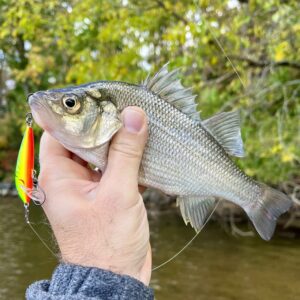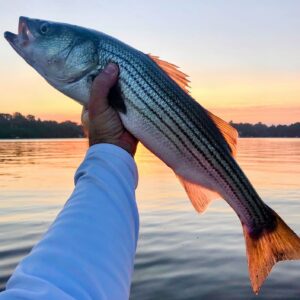Welcome to Reel Chesapeake’s Weekly Fishing Report, our interpretation of what’s biting and where throughout the Chesapeake Bay watershed. Please email us directly at editor@reelchesapeake.com to share updates and photographs of your recent catches for potential inclusion in next week’s column. The leading photograph (above): Rainbow trout caught on the fly from the Little Patuxent at Savage, Maryland, on February 1st. This fish hit a white woolly bugger. Photo by yours truly.
Mostly dry conditions across the region for the past week have greatly improved the water clarity in the tributaries and the main Chesapeake Bay. Though a spit of rain here and there has dropped, by and large the weather has cooperated for anglers and for the fish they’re trying to catch.
We’re into the last quarter of the moon phase and, heading into next week, the strongest tide cycles will occur during daylight, so take your pick of fishing the outgoing or incoming water and associated currents. Heading into this weekend, the region will get some of the cold front and high pressure that’s approaching from the Great Lakes region, but the forecast looks promising. We’ll have some gusts of wind push through Friday evening into Saturday, and by Sunday low pressure returns along with little to no wind heading into week two of February (and a Happy Groundhog Day to you, too, sir!).
I’m not going to sugarcoat it—the fishing sucked last week. The water was like chocolate milk throughout the Bay and tribs, and there was lots of debris pushing through the watersheds. The fish were turned off; it was a tough bite. Some guys—mostly charters—grinded it out. This week, the water settled and conditions greatly improved. Everyone seems happier.
Maryland Department of Natural Resources resumed preseason trout stocking with heavy concentrations of rainbows distributed in portions of the Little Patuxent River at Savage, Centennial Lake, Governor’s Bridge Ponds, Tuckahoe Creek on the Shore, and a few locations in and around Baltimore. And the fishing was excellent for them. I personally spent a couple mornings along the Little Pax fly casting stone nymphs and woolly buggers with some success (black worked better in shaded areas, white in sun drenched). Other anglers on site were spincasting tiny inline spinners or baited hooks and pulling up even more fish. Water flow was moderate and manageable with bends and holes holding the fish. The trout were fresh and feisty, and present an excellent opportunity to cure cabin fever. Check the Department’s Trout Stocking webpage for updates and locations.
Jigging for large, migratory striped bass remains as popular as ever. The reports coming from the middle to southern Chesapeake are nothing short of spectacular…if and when the fish are found. It takes a lot of effort and gas to search for the 40–50” hulks that are hugging the bottom. The eastern side of the shipping channel is where many reports originate. From the Chesapeake Bay Bridge south toward Bloody Point is a nice gradient of contours in the 25–75’ range, which offer a large swath worth searching for stripers. On a sunny and warmer than usual day (like this past Thursday), you may find fish moving into even shallower water >20’ to feed, especially later in the day after the water has warmed a couple degrees. Charter guides are generally departing from Kent Island/Eastern Bay, Annapolis/Sandy Point, Chesapeake Beach, Solomons, or Point Lookout. Warm water discharges—Calvert Cliffs, especially—draw in fish and are also worth drifting in and around.
The other big Bay fish that more and more anglers are catching on to (yes, literally and figuratively) is the blue catfish. And with the more settled weather conditions, we heard of several reports coming from the lower Susquehanna River. Anglers bottom fished with raw chicken breast, crushing heavyweight fish up to 40-pounds, and large numbers of 15–20-pounders. A go-to rig is the Santee Cooper using rattle floats; large circle hooks, 7/0 to 10/0 preferred. The fish are in the deepest water you can find and in most every river, along with channel cats, but especially in the Bush, Magothy, Choptank, Patuxent, and Potomac watersheds. Try closer to the mouths of the rivers this time of year.
The yellow perch bite seemed to pick up this past week with a few good reports coming from Eastern Shore tribs, including the Tuckahoe and Marshyhope. The fish are reportedly staged in the deeper holes ahead of their spawning waters, so jigging small offerings (stingers, nungessers, shad darts, and live minnows) in the deepest creek and river water you can find (outside edge of bends for example) should get you some fish. No word yet on perch showing up in popular holes such as Beachwood Park in the Magothy or Red Bridges of the Choptank.
This weekend, I’m planning to target chain pickerel in the Severn River. It’s been a spell and with the water clarity near normal and good weather forecasted, I suspect more anglers will do the same. There’s one month left in the Coastal Conservation Association Maryland’s annual Pickerel Championship. Now’s prime time to catch the largest specimens off docks, structure, and from the dead grass beds. Try 3–5” jerkbaits, slow rolling large spinnerbaits, size 3 or 4 inline spinners, or flukes on weedless jigheads around cover. Start with perch or firetiger colors to mimic the neds they target this time of year. Good luck!
This report appears within On The Water magazine’s weekly collection of Chesapeake Bay fishing reports.






